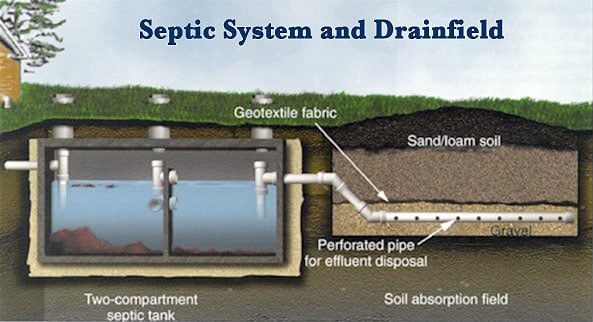In San Jose, and the bulk of the South Bay Area, most homes are connected to the city (or county) sewer system. For those of you who are not, you will be on a septic system. Part of that system is the septic tank. In this article, we will be taking a look at the septic tank, how it functions, and what to do if you have an issue with yours.

In San Jose, and the bulk of the South Bay Area, most homes are connected to the city (or county) sewer system. For those of you who are not, you will be on a septic system. Part of that system is the septic tank.
It’s important to understand that while being connected to a municipal sewer system can offer convenience and ease of maintenance, many homes in the area rely on septic systems for wastewater management. The septic tank plays a crucial role in this setup, serving as the initial point of waste collection and treatment before disposal or absorption into the surrounding soil.
At Gogo Rooter Plumbing, we specialize in providing trusted services for septic tank replacement in San Jose, CA, and surrounding areas. Our team of experienced plumbers is equipped with the knowledge and expertise to handle all aspects of septic system maintenance and repair.
Whether you need routine pumping, troubleshooting of septic tank issues, or complete replacement, you can rely on us to deliver efficient and cost-effective solutions.
Are you searching for reliable septic tank services in San Jose? Look no further! Our team at Gogo Rooter Plumbing specializes in providing top-notch solutions for all your septic system needs. Whether you require routine cleaning, thorough inspections, or even septic tank repair, we’ve got you covered.
Maintaining a healthy septic system is crucial for the smooth operation of your household. With our expert service, you can ensure that your septic tank remains in optimal condition, minimizing the risk of costly repairs down the line. Our experienced technicians are equipped with the latest tools and knowledge to handle any issue that may arise, from minor clogs to major system overhauls.
When it comes to septic tank cleaning, our thorough and efficient approach ensures that every inch of your system is properly maintained. We use environmentally friendly cleaning agents to remove buildup and prevent future issues, keeping your septic system running smoothly for years to come.
In addition to cleaning, we also offer comprehensive septic tank repair services. Whether you’re dealing with a leak, a damaged baffle, or any other issue, our team has the expertise to diagnose and resolve the problem quickly and effectively. We understand the importance of prompt repairs when it comes to septic systems, and we’ll work tirelessly to restore your system to full functionality.
If you’re in need of a new septic tank installation, we can handle that too. Our team will work with you to determine the best solution for your property, taking into account factors such as size, location, and budget. With our expert guidance, you can rest assured that your new septic system will be installed correctly and efficiently.
At Gogo Rooter Plumbing, we take pride in providing exceptional service to our customers in the San Jose area. Whether you need routine maintenance or emergency repairs, you can count on us to deliver reliable solutions tailored to your specific needs. Contact us today to schedule your septic tank service and experience the difference firsthand!
We covered this a bit in our Absorption Field article, but knowing how a septic tank works can be a great first step towards making sure your works efficiently.
Any time you use a fixture that results in water/waste flowing down the drain, it will travel through the drain pipes, into your house mainline, and then into the septic tank. Once there, the tank does a few things. The first thing it does is separate the waste into three parts.
Scum – The scum is the lightest parts of the waste that floats on the top. It is kept within the tank either by baffles, barriers, or a “tee” in the outlet pipe. It is important that this scum not make it into the drain field.
Liquid – The liquid is allowed to flow through the outlet pipe into the absorption field, where it is treated and returned to the water table.
Sludge – The heaviest of the waste settles at the bottom of the tank, as sludge. The sludge (and to a lesser degree, the scum) is what must be periodically pumped from the tank.
Besides just separating the waste into these three parts, the septic tank has another very useful function. As the waste accumulates within the tank, a natural bacteriological process breaks down the scum and sludge, and begins to break down and neutralize the toxins. While most of the liquid waste treatment is done in the absorption field, a proper bacteria balance in the tank is important.
While septic systems were the staple for sewage treatment for many, many years, they are far from full proof. By far, the most common cause for septic problems is lack of maintenance. Septic tanks need regular pumping to keep the solids from building up to a point where they can enter the drain field. If that happens, it will ruin the drain field’s ability to drain.
You do not need, or want to use septic tank treatment chemicals. These chemicals do not help to break down the waste, and in many cases can actually upset the natural balance in your tank. In other words, they can actually make matters worse!
Another problem that sometimes occurs is when the baffles, or tees somehow get damaged. If this happens, the sludge may be able to get directly into the outlet pipe, and wreak havoc on your absorption field. For this reason, it is important that the tank is thoroughly checked every time a maintenance is performed, and any damage repair immediately.
The two most difficult issues to repair are failures of the drain field, or damage to the tank itself. We discussed the former in our Septic Field Pipe Repair article, but what about the tank? Unfortunately, if the tank itself goes bad, it will usually have to be replaced. This is especially true of older tanks.
Replacing a septic tank can turn out to be a pretty big job. Before starting anything of this magnitude, you may want to see if you have an option to abate your current septic system, and get your home connected to the city (or county) sewer. While septic abatement is a pretty large job as well, being tied into the municipal sewage treatment system is far more efficient, and cost effective, over the long term.
If you would like to know more about septic systems, or need help with your septic tank, give us a call. We will get a qualified, friendly Gogo Rooter Plumber to your door, ASAP.
For your convenience, here is a handy little guide to septic tank maintenance from the DHEC.
https://scdhec.gov/environment/septic-tanks/septic-tanks-preventative-routine-maintenance
**picture courtesy of Natural Environmental Services Center
Signs that your septic system may need repair include foul odors, slow drainage, pooling water in the yard, or gurgling sounds from drains. If you notice any of these issues, it’s crucial to contact septic services in San Jose promptly to assess and address the problem.
Regular septic tank cleaning is essential for maintaining a healthy septic system. Depending on your household size and usage, it’s recommended to schedule septic tank cleaning every 3 to 5 years to prevent buildup and ensure optimal system performance.
A septic system field inspection assesses the condition of the drainage field, also known as the leach field, to ensure proper functioning and identify any issues such as saturation or clogging. Regular inspections by qualified septic services in San Jose can help prevent costly repairs and extend the lifespan of your system.
If you notice signs of septic tank damage such as cracks, leaks, or structural issues, it’s essential to seek professional septic tank repair services in San Jose promptly. Delaying repairs can lead to further damage and compromise the integrity of your entire septic system.
Septic tank pumping service involves removing accumulated solids and liquids from the tank to prevent overflow and maintain proper functionality. Regular septic tank pumping by licensed professionals in San Jose is essential for preventing backups and ensuring the longevity of your septic system.
Yes, several preventative measures can help prolong the life of your septic system and minimize the need for repairs. These include practicing water conservation, avoiding flushing non-biodegradable items, scheduling regular septic tank cleaning, and investing in professional septic system inspections and maintenance services in San Jose.
When selecting a septic services company for maintenance and repairs in San Jose, it’s essential to choose a licensed and experienced provider with a track record of excellence. Look for companies that offer comprehensive services, including septic tank cleaning, pumping, inspection, and repair, to ensure all your septic system needs are met efficiently and effectively.

"*" indicates required fields